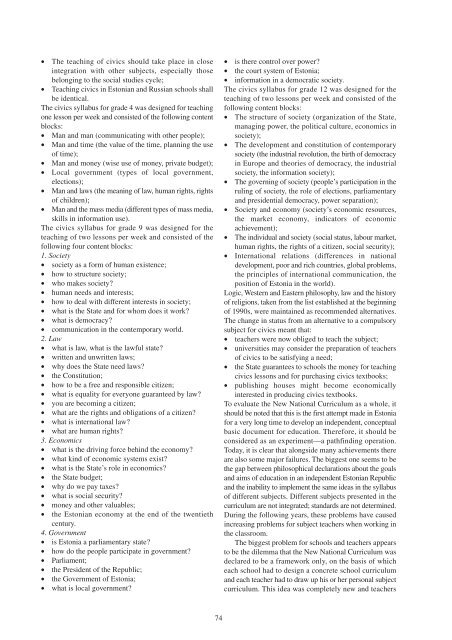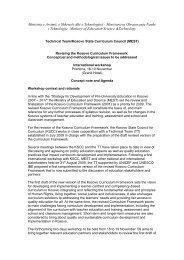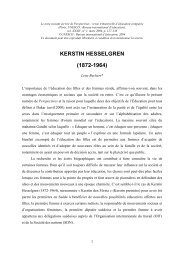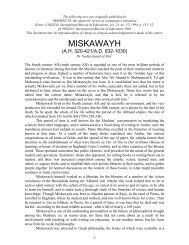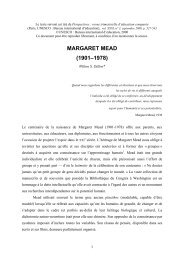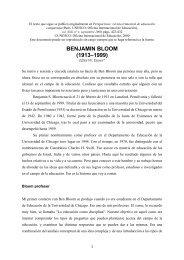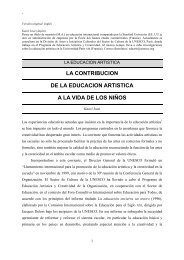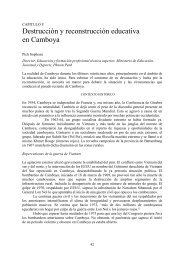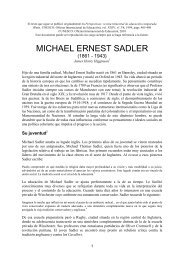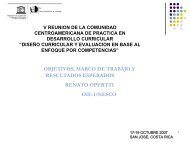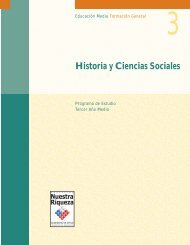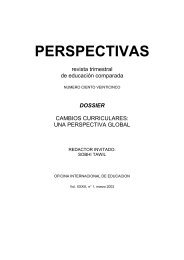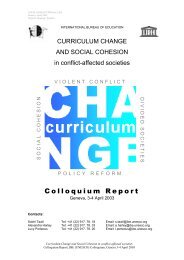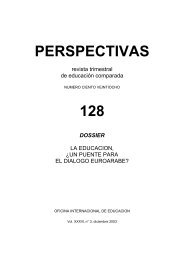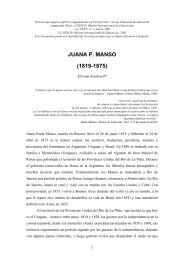Curriculum Change and Social Inclusion - International Bureau of ...
Curriculum Change and Social Inclusion - International Bureau of ...
Curriculum Change and Social Inclusion - International Bureau of ...
Create successful ePaper yourself
Turn your PDF publications into a flip-book with our unique Google optimized e-Paper software.
• The teaching <strong>of</strong> civics should take place in close<br />
integration with other subjects, especially those<br />
belonging to the social studies cycle;<br />
• Teaching civics in Estonian <strong>and</strong> Russian schools shall<br />
be identical.<br />
The civics syllabus for grade 4 was designed for teaching<br />
one lesson per week <strong>and</strong> consisted <strong>of</strong> the following content<br />
blocks:<br />
• Man <strong>and</strong> man (communicating with other people);<br />
• Man <strong>and</strong> time (the value <strong>of</strong> the time, planning the use<br />
<strong>of</strong> time);<br />
• Man <strong>and</strong> money (wise use <strong>of</strong> money, private budget);<br />
• Local government (types <strong>of</strong> local government,<br />
elections);<br />
• Man <strong>and</strong> laws (the meaning <strong>of</strong> law, human rights, rights<br />
<strong>of</strong> children);<br />
• Man <strong>and</strong> the mass media (different types <strong>of</strong> mass media,<br />
skills in information use).<br />
The civics syllabus for grade 9 was designed for the<br />
teaching <strong>of</strong> two lessons per week <strong>and</strong> consisted <strong>of</strong> the<br />
following four content blocks:<br />
1. Society<br />
• society as a form <strong>of</strong> human existence;<br />
• how to structure society;<br />
• who makes society?<br />
• human needs <strong>and</strong> interests;<br />
• how to deal with different interests in society;<br />
• what is the State <strong>and</strong> for whom does it work?<br />
• what is democracy?<br />
• communication in the contemporary world.<br />
2. Law<br />
• what is law, what is the lawful state?<br />
• written <strong>and</strong> unwritten laws;<br />
• why does the State need laws?<br />
• the Constitution;<br />
• how to be a free <strong>and</strong> responsible citizen;<br />
• what is equality for everyone guaranteed by law?<br />
• you are becoming a citizen;<br />
• what are the rights <strong>and</strong> obligations <strong>of</strong> a citizen?<br />
• what is international law?<br />
• what are human rights?<br />
3. Economics<br />
• what is the driving force behind the economy?<br />
• what kind <strong>of</strong> economic systems exist?<br />
• what is the State’s role in economics?<br />
• the State budget;<br />
• why do we pay taxes?<br />
• what is social security?<br />
• money <strong>and</strong> other valuables;<br />
• the Estonian economy at the end <strong>of</strong> the twentieth<br />
century.<br />
4. Government<br />
• is Estonia a parliamentary state?<br />
• how do the people participate in government?<br />
• Parliament;<br />
• the President <strong>of</strong> the Republic;<br />
• the Government <strong>of</strong> Estonia;<br />
• what is local government?<br />
74<br />
• is there control over power?<br />
• the court system <strong>of</strong> Estonia;<br />
• information in a democratic society.<br />
The civics syllabus for grade 12 was designed for the<br />
teaching <strong>of</strong> two lessons per week <strong>and</strong> consisted <strong>of</strong> the<br />
following content blocks:<br />
• The structure <strong>of</strong> society (organization <strong>of</strong> the State,<br />
managing power, the political culture, economics in<br />
society);<br />
• The development <strong>and</strong> constitution <strong>of</strong> contemporary<br />
society (the industrial revolution, the birth <strong>of</strong> democracy<br />
in Europe <strong>and</strong> theories <strong>of</strong> democracy, the industrial<br />
society, the information society);<br />
• The governing <strong>of</strong> society (people’s participation in the<br />
ruling <strong>of</strong> society, the role <strong>of</strong> elections, parliamentary<br />
<strong>and</strong> presidential democracy, power separation);<br />
• Society <strong>and</strong> economy (society’s economic resources,<br />
the market economy, indicators <strong>of</strong> economic<br />
achievement);<br />
• The individual <strong>and</strong> society (social status, labour market,<br />
human rights, the rights <strong>of</strong> a citizen, social security);<br />
• <strong>International</strong> relations (differences in national<br />
development, poor <strong>and</strong> rich countries, global problems,<br />
the principles <strong>of</strong> international communication, the<br />
position <strong>of</strong> Estonia in the world).<br />
Logic, Western <strong>and</strong> Eastern philosophy, law <strong>and</strong> the history<br />
<strong>of</strong> religions, taken from the list established at the beginning<br />
<strong>of</strong> 1990s, were maintained as recommended alternatives.<br />
The change in status from an alternative to a compulsory<br />
subject for civics meant that:<br />
• teachers were now obliged to teach the subject;<br />
• universities may consider the preparation <strong>of</strong> teachers<br />
<strong>of</strong> civics to be satisfying a need;<br />
• the State guarantees to schools the money for teaching<br />
civics lessons <strong>and</strong> for purchasing civics textbooks;<br />
• publishing houses might become economically<br />
interested in producing civics textbooks.<br />
To evaluate the New National <strong>Curriculum</strong> as a whole, it<br />
should be noted that this is the first attempt made in Estonia<br />
for a very long time to develop an independent, conceptual<br />
basic document for education. Therefore, it should be<br />
considered as an experiment—a pathfinding operation.<br />
Today, it is clear that alongside many achievements there<br />
are also some major failures. The biggest one seems to be<br />
the gap between philosophical declarations about the goals<br />
<strong>and</strong> aims <strong>of</strong> education in an independent Estonian Republic<br />
<strong>and</strong> the inability to implement the same ideas in the syllabus<br />
<strong>of</strong> different subjects. Different subjects presented in the<br />
curriculum are not integrated; st<strong>and</strong>ards are not determined.<br />
During the following years, these problems have caused<br />
increasing problems for subject teachers when working in<br />
the classroom.<br />
The biggest problem for schools <strong>and</strong> teachers appears<br />
to be the dilemma that the New National <strong>Curriculum</strong> was<br />
declared to be a framework only, on the basis <strong>of</strong> which<br />
each school had to design a concrete school curriculum<br />
<strong>and</strong> each teacher had to draw up his or her personal subject<br />
curriculum. This idea was completely new <strong>and</strong> teachers


